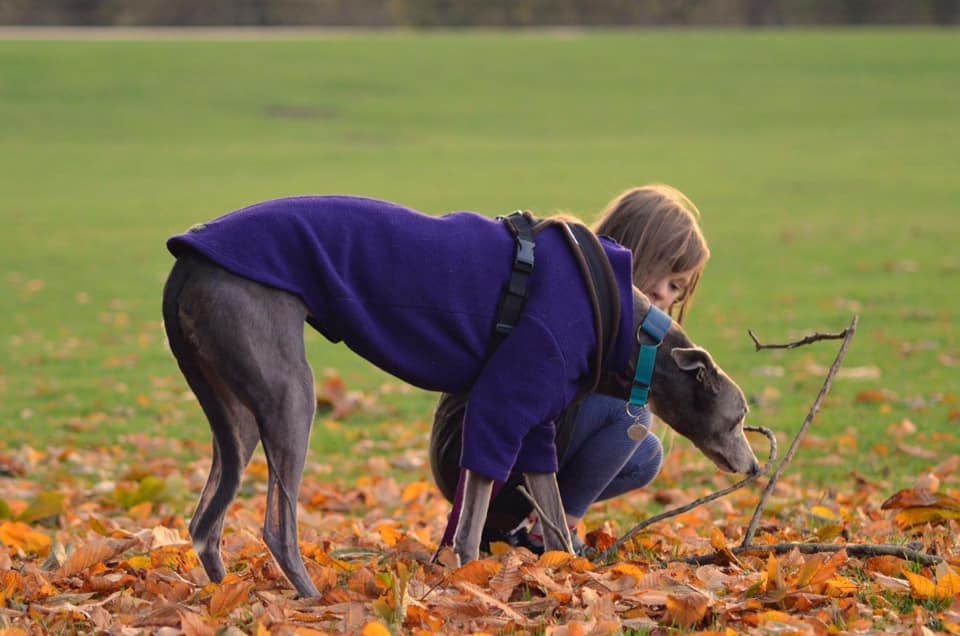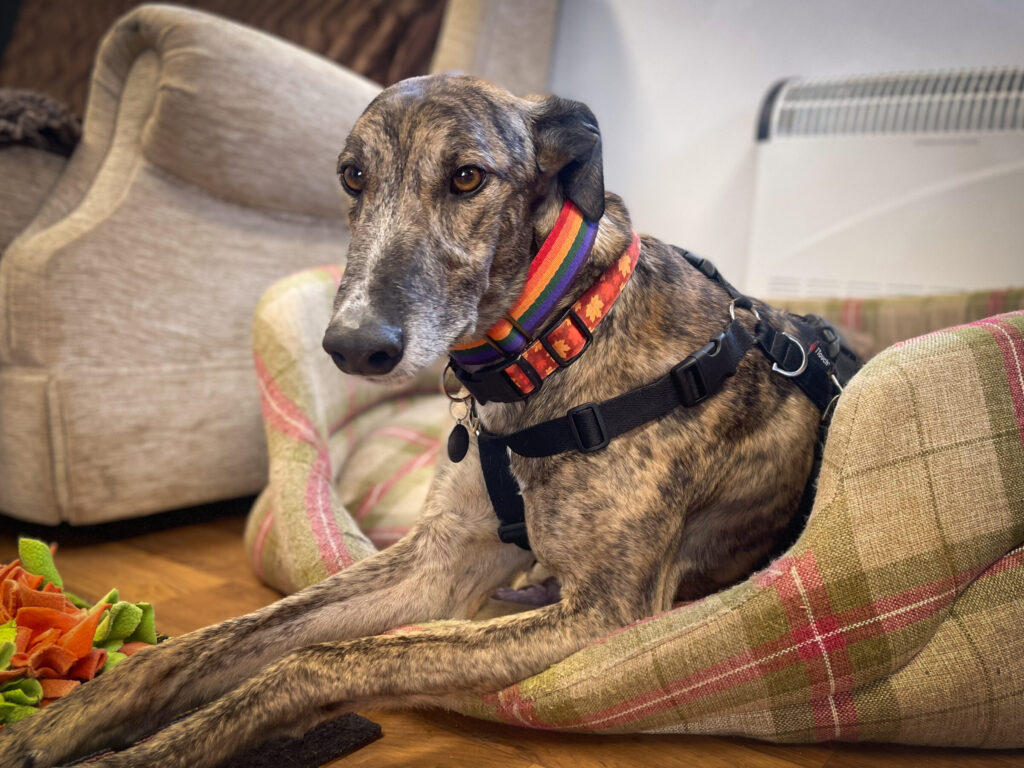
At Forever Hounds Trust, we understand that finding your new canine family member can sometimes feel like a near impossible task! People sometimes comment that rescue organisations place too many restrictions on the type of home each dog is looking for, making it difficult for people to welcome a rescue dog into their home. When it comes to adopting one of our hounds, Forever Hounds Trust actually have very few blanket rules in place. We will (and regularly do) place dogs in homes without gardens, with people who work full time, with young children, with elderly people, as only pets, with small breed dogs and even with cats! So why can it seem like so many of our dogs have such specific homing criteria?
There are two main reasons that responsible rescue organisations have to be cautious when setting homing criteria for our dogs. Firstly, being adopted and then returned to kennels because things didn’t work out in their new home can have a huge psychological impact on a dog. They don’t understand why their environment has changed again, when they were just starting to feel at home. Each time this happens, the dog will find it harder to settle and relax in the next home – they don’t know if they’re coming or going! This is why we need to do everything in our power to get the right match first time.
Even more importantly, Forever Hounds Trust has a duty of care not only to the dogs we take in, but to the families we adopt those dogs out to, as well as the general public and their pets. We need to be sure that we’re not putting anyone at risk when we place a dog in their new home. The consequences of getting things wrong could be huge, especially where children or smaller animals are involved! This means that as a responsible rescue organisation, we need to be totally confident that we’re placing the right dog in the right home.
When we take a dog in from a pet home, we have the opportunity to get a wealth of information about the dog from their previous family – their likes and dislikes, details of any behaviour issues, fears or phobias, as well details on how they behave around children, cats and other dogs. When a dog has a detailed home history, we can be very confident on how we expect the dog to cope in different home environments and situations. The risk of a dog being returned as a result of issues such as not getting along with the resident children or existing pets, or not coping with being left alone is minimal when we know for sure that the dog has coped well with these things in the past.

Sadly, this is a luxury we don’t have for the majority of our dogs. Very few of the dogs that Forever Hounds Trust take in have spent their lives in loving homes. Almost all of our greyhounds come directly from the racing industry, and most of these dogs have had extremely limited experience of the “real world” before arriving with us. They have generally never lived in a home before, and have rarely been socialised with children or different breeds of dog. We may get a small amount of information on the personality of each dog, but this is usually very minimal, if not non-existent. Our lurchers typically come to us with absolutely no history at all – they have usually been found straying, most likely having spent their life as a hunting dog.
This is where our behaviour assessments come in! As a responsible rehoming organisation, we need to be sure that we get to know our dogs as well as we possibly can – especially since we’re usually starting from scratch! All our assessments are carried out by qualified dog behaviour specialists and highly experienced dog handlers, who are properly trained and extremely skilled in observing dog behaviour. By observing our dogs in situations and environments which they’re likely to experience once adopted out into a forever home, we can start to build a picture of the type of home each dog needs. Some of the main areas we focus on include, but are not limited to:
- Observing the dog in different environments, such as rural walks, dog parks and more urban areas.
- Observing how the dog responds to meeting different people, both adults and children.
- Observing how the dog responds to being fussed, cuddled and handled.
- Observing how the dog responds to meeting and interacting with other dogs, of various shapes, sizes and breeds.
- Observing how the dog behaves around resources such as food, toys and resting areas.
- Observing how to dog behaves when they have the support of another dog, compared to on their own.
- Observing how the dog copes with being inside a home type environment.



Based on the assessment, we can start to build a picture of each dog’s homing needs. This is a shopping list of things that they definitely need in order to settle in their new home (or definitely won’t be able to cope with) as well as things which would be ideal, but are negotiable. The dogs that we take in will fall somewhere on a spectrum from those who have very few particular homing needs and could fit into most homes, all the way up to those who we know will only thrive in a very specific environment.
Unsurprisingly, the more specific homing criteria a dog has, the more difficult it is to find the right home for them. These dogs tend to be with us for much longer, and therefore you are more likely to see them featured on our social media posts. This is especially true because we try to give the overlooked dogs as much of the limelight as possible, in hopes that their perfect match will notice them! This can make it seem like all of our dogs have very restrictive homing needs, when in reality these dogs are in the minority.
Dogs with fewer specific needs are highly sought after – if a dog is able to live with young children, is house trained and used to home life, is friendly with every dog they meet or can live with cats, they’re going to have people queueing up to adopt them, therefore, there could be a longer waitlist for a dog like this. Whilst all our dogs are put on our website as ‘Newly Arrived’ it might soon become apparent during their assessment that they will be a perfect match for someone already on our waiting list. So, the dog may be homed before they are made available for general applications. Therefore, we would always recommend submitting a general application so that we can consider you as a potential home for our new dogs as soon as they’re assessed and ready to go!

Realistically, it does usually take us longer to find suitable matches for some home offers. In the case of families with young children, this is because we simply cannot take any risks with their safety. Although our assessments are extremely thorough, without home history they can never be 100% fool proof. Sometimes dogs can behave very differently once they move into their new home – either for better or for worse! This means that in order to confidently place a dog without history into a home with young children, we must have seen extremely strong evidence that they are comfortable around children (and all of the strange things that children might decide to do!) and that they do not pose a bite risk. In the case of homes with cats, we simply don’t have the ability to properly assess our dogs around cats – so given their backgrounds and previous experiences, we have to err on the side of caution, unless we have history to suggest that the dog doesn’t pose a risk to small furries.
Like all rescue organisations, our goal is to find forever homes for dogs who would otherwise not have that chance. We want to save as many dogs as we can, so keeping them in kennels longer than needed, based on unnecessarily strict homing restrictions would make no sense at all! However, we know from experience that it is both pointless and irresponsible to place a dog into a home environment which we know is unsuitable, and simply hope for the best.
So please rest assured that when we set homing criteria for a dog, we’re doing so in the best interests not only of that dog, but of yourself as a potential adopter.



 Our Winter Appeal
Our Winter Appeal